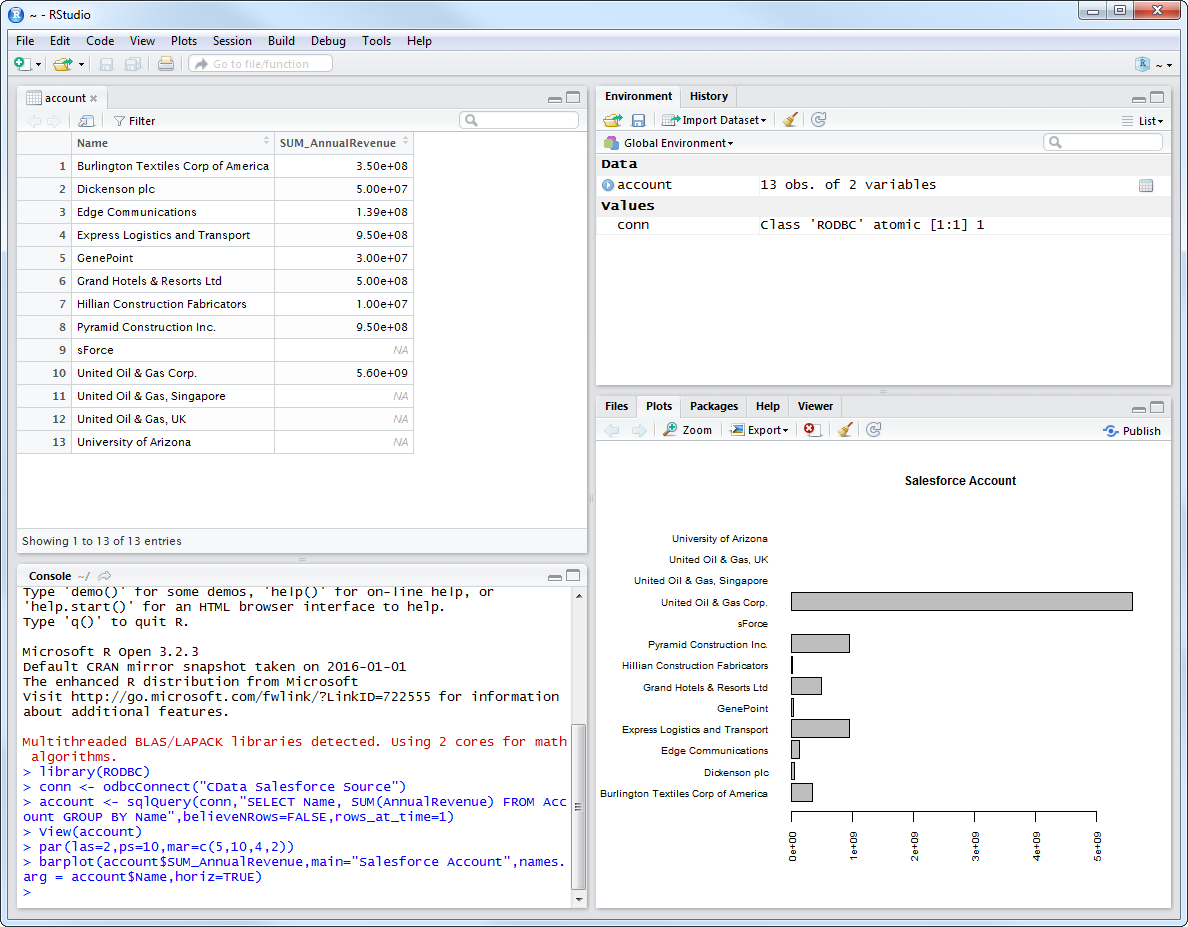Discover how a bimodal integration strategy can address the major data management challenges facing your organization today.
Get the Report →Analyze TaxJar Data in R
Create data visualizations and use high-performance statistical functions to analyze TaxJar data in Microsoft R Open.
Access TaxJar data with pure R script and standard SQL. You can use the CData ODBC Driver for TaxJar and the RODBC package to work with remote TaxJar data in R. By using the CData Driver, you are leveraging a driver written for industry-proven standards to access your data in the popular, open-source R language. This article shows how to use the driver to execute SQL queries to TaxJar data and visualize TaxJar data in R.
Install R
You can complement the driver's performance gains from multi-threading and managed code by running the multithreaded Microsoft R Open or by running R linked with the BLAS/LAPACK libraries. This article uses Microsoft R Open (MRO).
Connect to TaxJar as an ODBC Data Source
Information for connecting to TaxJar follows, along with different instructions for configuring a DSN in Windows and Linux environments.
To authenticate to the TaxJar API, you will need to first obtain the API Key from the TaxJar UI.
NOTE: the API is available only for Professional and Premium TaxJar plans.
If you already have a Professional or Premium plan you can find the API Key by logging in the TaxJar UI and navigating to Account -> TaxJar API. After obtaining the API Key, you can set it in the APIKey connection property.
Additional Notes
- By default, the CData connector will retrieve data of the last 3 months in cases where the entity support date range filtering. You can set StartDate to specify the minimum creation date of the data retrieved.
- If the API Key has been created for a sandbox API account please set UseSandbox to true, but not all endpoints will work as expected. For more information, refer to the TaxJar developer documentation.
When you configure the DSN, you may also want to set the Max Rows connection property. This will limit the number of rows returned, which is especially helpful for improving performance when designing reports and visualizations.
Windows
If you have not already, first specify connection properties in an ODBC DSN (data source name). This is the last step of the driver installation. You can use the Microsoft ODBC Data Source Administrator to create and configure ODBC DSNs.
Linux
If you are installing the CData ODBC Driver for TaxJar in a Linux environment, the driver installation predefines a system DSN. You can modify the DSN by editing the system data sources file (/etc/odbc.ini) and defining the required connection properties.
/etc/odbc.ini
[CData TaxJar Source]
Driver = CData ODBC Driver for TaxJar
Description = My Description
APIKey = 3bb04218ef8t80efdf1739abf7257144
For specific information on using these configuration files, please refer to the help documentation (installed and found online).
Load the RODBC Package
To use the driver, download the RODBC package. In RStudio, click Tools -> Install Packages and enter RODBC in the Packages box.
After installing the RODBC package, the following line loads the package:
library(RODBC)
Note: This article uses RODBC version 1.3-12. Using Microsoft R Open, you can test with the same version, using the checkpoint capabilities of Microsoft's MRAN repository. The checkpoint command enables you to install packages from a snapshot of the CRAN repository, hosted on the MRAN repository. The snapshot taken Jan. 1, 2016 contains version 1.3-12.
library(checkpoint)
checkpoint("2016-01-01")
Connect to TaxJar Data as an ODBC Data Source
You can connect to a DSN in R with the following line:
conn <- odbcConnect("CData TaxJar Source")
Schema Discovery
The driver models TaxJar APIs as relational tables, views, and stored procedures. Use the following line to retrieve the list of tables:
sqlTables(conn)
Execute SQL Queries
Use the sqlQuery function to execute any SQL query supported by the TaxJar API.
orders <- sqlQuery(conn, "SELECT TransactionID, UserID FROM Orders WHERE TransactionID = '123'", believeNRows=FALSE, rows_at_time=1)
You can view the results in a data viewer window with the following command:
View(orders)
Plot TaxJar Data
You can now analyze TaxJar data with any of the data visualization packages available in the CRAN repository. You can create simple bar plots with the built-in bar plot function:
par(las=2,ps=10,mar=c(5,15,4,2))
barplot(orders$UserID, main="TaxJar Orders", names.arg = orders$TransactionID, horiz=TRUE)







